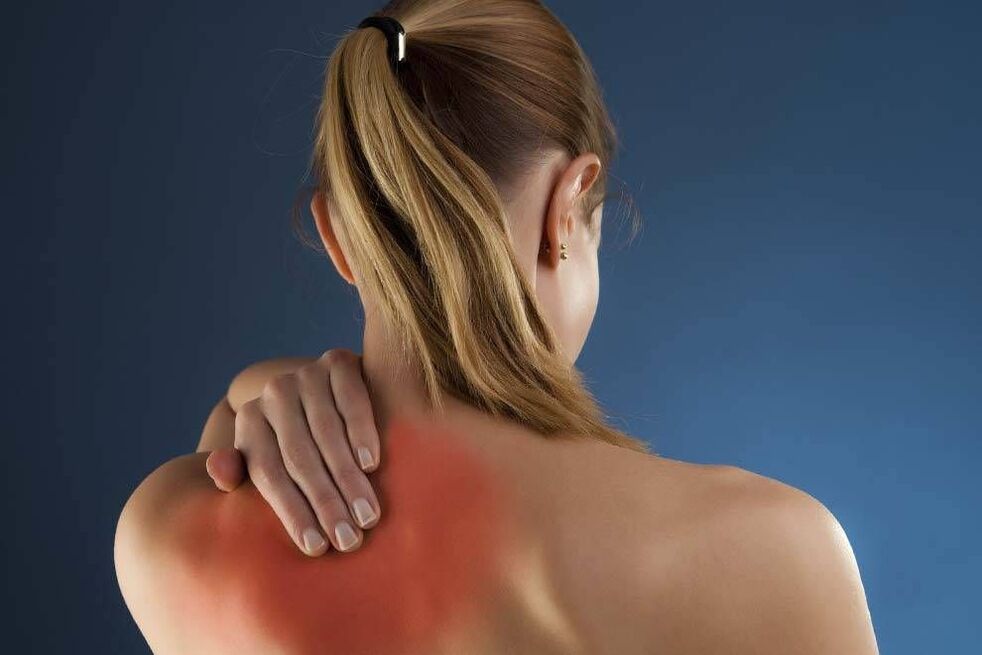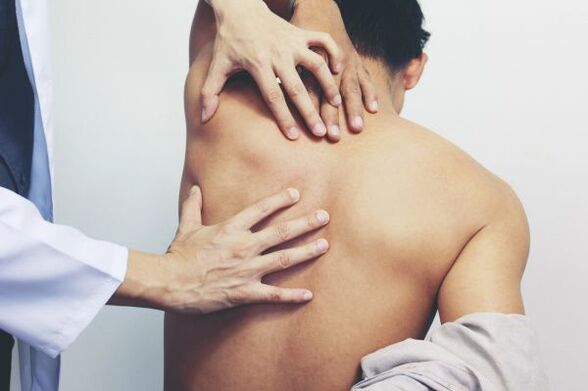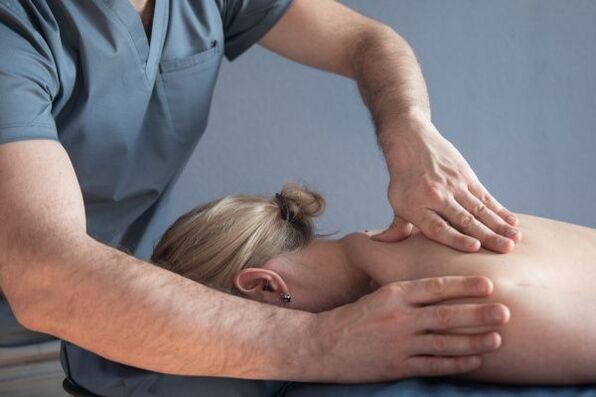
Pain under left shoulder bladeobserved in musculoskeletal pathologies (osteonecrosis, myofascial syndrome, trauma), heart diseases (myocardial infarction, angina, rheumatic and non-rheumatic carditis), gastrointestinal diseases(pancreatitis, stomach ulcer). Rare causes of this symptom include spleen damage, ulcers, and skin tumors. Diagnostic methods are selected based on the underlying syndrome: using X-ray, ultrasound and endoscopy. To relieve pain, painkillers are prescribed, after which medical or surgical treatment of the underlying disease is carried out.
Causes of pain under the left shoulder blade
Nerve root syndrome
The pathological condition develops with thoracic osteochondrosis or intervertebral herniation. Less commonly, radicular pain occurs with spondylolisthesis and ankylosing spondylitis. Acute pain in the protrusion of the left scapula is noted when the 3-6th thoracic roots participate in the process; An unpleasant feeling just below the shoulder blade indicates the localization of damage to the 7-8th vertebrae. Usually, the pain spreads from the shoulder blades to the lateral surface of the chest and intercostal spaces.
Myofascial pain syndrome
Poor posture and staying in an uncomfortable position for long periods of time lead to constant muscle tension. The syndrome is manifested by pain in the left shoulder blade area, when the load is mainly on this side. The patient feels deep and moderate discomfort. At first, the pain appears only with movement and exertion, but over time it becomes constant. Sometimes diffuse pain appears in the left forearm or hand.
Injury
Severe pain develops after a crack or fracture of the shoulder blade or bruising of the soft tissue over this area. If the bones are preserved intact, the pain level is moderate, the patient can breathe deeply and move freely. When injury to the bone structure occurs, sharp pain appears and mobility of the arm and shoulder girdle is often limited. When changing positions or pressing on the injured area, you will feel a sharp pain.

Boils and boils
Purulent inflammation of the skin around the left shoulder blade is accompanied by severe pain, often clearly localized. As the pimple matures, a "tugging" feeling appears, this feeling is increased when palpating or rubbing the inflamed skin with clothing. After the tire is punctured and the necrotic core escapes, the pain gradually decreases. With boils, the pain is more intense, and the patient's general condition often worsens.
Heart-related diseaes
Cardiac lesions are a typical cause of pain under the left scapula, related to the proximity of the anatomical location and the characteristics of the nerve distribution. In this case, the symptoms are accompanied by pain in the chest of various types, a feeling of numbness or disruption of heart activity. Tachycardia and other arrhythmias are often detected. Pain under the shoulder blade manifests as follows:
- Heart attack.Patients have an unpleasant burning sensation, spreading from the precordial area to the left arm and shoulder blade, and less commonly to the clavicle and neck area. This condition occurs suddenly and is accompanied by intense fear of death and fainting.
- Stable angina.Pain caused by squeezing or pressing down to the area below the shoulder blade is characteristic of ischemic heart disease attacks. The unpleasant symptoms are provoked by physical activity or emotional stress and last on average up to 10-15 minutes. After resting or taking nitrates, the pain disappears.
- Inflammatory heart disease. Dull or stabbing pain in the chest that spreads to the left shoulder blade and makes the patient uncomfortable for several days, is typical of acute myocarditis (myocarditis, pericarditis). Patients also complain of shortness of breath, increased body temperature and swelling of the lower limbs.
- Rheumatism.Diffuse pain in the left side of the back combined with myocardial pain characterizes the clinical picture of rheumatoid arthritis. The clinical picture is complemented by arthralgia, annular erythema on the skin and rheumatic nodules. Symptoms are often detected in children and adolescents.
Pancreatitis
Low back pain moving from the left lower quadrant to the subscapular region is observed in acute pancreatitis. In addition to the pain syndrome, the patient is also worried about debilitating vomiting due to impurities of bile and mucus, and tension in the abdominal muscles. Movement increases the feeling of pain, so the patient tries to lie motionless on his side.
In chronic pancreatitis, irradiation of subscapular pain indicates an exacerbation of the process. Most often, violations occur due to errors in diet - large parties, drinking alcohol. The pain is paroxysmal, sometimes spreading not only to the area under the shoulder but also to the precordial area. Symptoms are associated with nausea, bloating and celiac diarrhea.
Stomach ulcers
Pain under the left shoulder blade is a localized sign of the defect in the posterior wall of the stomach, closer to the back. The feeling of discomfort appears within 20-50 minutes after eating. The earlier the symptoms appear, the higher the location of the ulcer. The discomfort becomes worse when eating sour, spicy or fried foods. To reduce the intensity of pain, the patient induces vomiting.
Spleen disease
Pain and a feeling of fullness in the left subscapular region occur with splenomegaly due to infectious, autoimmune, or myeloproliferative processes. With the gradual enlargement of the organ, periodic discomfort develops accompanied by a feeling of heaviness in the affected area and a rapid change in the size of the spleen accompanied by sharp pains radiating to the lower part of the body. left shoulder blade.
Less often, the cause of pain is surgical pathology of the spleen: rupture, infarction, volvulus. In this case, there are cutting or throbbing pains radiating under the shoulder blades, aggravated by the slightest movement. Therefore, the patient must be in the required position: lying on the left side or on the back, knees hugging the abdomen. The clinical picture is complemented by a sharp decrease in blood pressure and tachycardia. In the absence of adequate pain relief, shock will occur.
bronchopulmonary disease
Localized left pulmonary processes often cause pain in the projection of the scapula. The discomfort increases with deep breathing, laughing, talking, and coughing. The pain has a variety of qualities: sharp, stabbing, dull, pressing. They are accompanied by fever, difficulty breathing, and other typical respiratory symptoms. Typically, patients experience pain under the left shoulder blade when:
- Pneumonia.The patient feels a moderate dull pain, clearly localized in the case of localized pneumonia or spreading throughout the shoulder blade area in the case of lobar pneumonia. A deep cough appears accompanied by the secretion of mucus. Symptoms last up to 2-4 weeks.
- Pleurisy.With exudative pleurisy, a person feels pressure and rupture under the shoulder blades and along the side wall of the chest. As you feel this area, the discomfort increases. Dry pleurisy is characterized by acute pain in the chest and subscapular region, aggravated by movement.
- Tuberculosis.The TB infection is long-lasting so the low-intensity pain lasts for several months. If the pain is localized in the shoulder blade area, the focus of pathology is more likely to be in the posterior segments of the lungs.
- Pulmonary infarction.Partial death of lung parenchyma is manifested by severe pain radiating below the left shoulder blade, clinically resembling angina. The patient's condition is complicated by hemoptysis or pulmonary hemorrhage, external respiratory dysfunction, and cardiac arrhythmia.
Rare cause
- Tumor: osteomas and bone cancers, bone cysts, malignant tumors of the skin above the shoulder blade (basal cell carcinoma, melanoma).
- Cardiovascular disease is rare: cardiac syndrome X, descending aortic aneurysm.
- Acute surgical illness: retroperitoneal abscess, hemoperitoneum, strangulated diaphragmatic hernia.
Diagnose
Patients with pain below the left scapula are first referred to an orthopedic traumatologist for consultation. If there is no disorder of the musculoskeletal system, other specialists will participate in the search for a diagnosis: neurologists, cardiologists, surgeons, etc. v. To determine the cause of pain, a series of specific studies are indicated, including:
- X-ray.X-rays of the scapula in anterior and lateral views allow injury to be ruled out or confirmed. X-rays of the spine are indicated when cartilage degeneration, scoliosis or spondylolisthesis are suspected. Routine x-rays of the chest cavity allow one to suspect damage to the lungs or heart.
- ECG.The standard 12-lead ECG is a screening method, based on the results of which the doctor makes a preliminary diagnosis and identifies dangerous processes (myocardial infarction, life-threatening arrhythmia). The diagnostic complex is supplemented by classical or transesophageal echocardiography and cardiac electrophysiology.
- Ultrasound of abdominal organs.A quick and non-invasive method is used to detect common conditions that cause pain in the left shoulder blade. Ultrasound showed signs of gastric ulcer, pancreatic infiltrate, and spleen enlargement. To clarify the diagnosis of duodenal ulcer, EGD is used.
- Additional methods. To clarify the nature and severity of the skeletal changes, a CT or MRI of the spine will be performed. In cases of possible bronchopulmonary disease, bronchoscopy with biopsy and pleural puncture is performed. If there is difficulty in diagnosing abdominal pathology, diagnostic laparoscopy should be performed.
Laboratory testing methods play an important role in diagnosis. Clinical blood tests show signs of inflammation or disruption of hematopoiesis. Acute-phase protein indices and protein profiles are informative in cases of possible cardiac injury or autoimmune processes. Specific myocardial markers are evaluated to identify angina.
To diagnose diseases of the gastrointestinal tract, a simultaneous program is carried out: the presence of pancreatitis is indicated by a high content of undigested food particles, an increase in the number of striated muscle fibers and granulesstarch. In the case of inflammatory processes in the lungs and pleura, bacterial inoculation of biological material is necessary, followed by sensitivity testing of isolated microorganisms to antibiotics.

Treatment
Help before diagnosis
Considering the variety of causes of pain under the left shoulder blade, it is difficult for the doctor to give recommendations until the underlying pathology is determined. During the examination, it is recommended to reduce the load on the back muscles to eliminate simple fatigue and exertion that can cause persistent pain symptoms. If the sensation becomes unbearable, pain medication will be administered and the patient must be hospitalized immediately.
Conservation therapy
The treatment plan is selected only after a complete diagnosis and identification of etiological factors of pain under the left scapula. If the patient feels severe discomfort, anti-inflammatory drugs and muscle relaxants should be used to quickly relieve painful sensations. For severe pain, blockade treatment and the use of narcotic analgesics are effective. Taking into account the disease, a mode of physical activity is chosen.
Drug treatment is prescribed by a specialist with appropriate records. For pain caused by heart damage, the cardiologist prescribes anti-anginal and anti-arrhythmic drugs, antiplatelet and anticoagulant drugs, and antihypertensive drugs. Diseases of the bronchopulmonary system require the participation of a pulmonologist and the use of antibiotics, expectorants, and specific antituberculosis drugs.
For diseases of the gastrointestinal tract, a suitable diet is selected and therapy is supplemented with enzyme preparations, promotility drugs, antacids and antisecretory drugs. In neurology, nerve metabolites, B vitamins and drugs that improve microcirculatory and rheological properties of blood are prescribed to eliminate nerve root syndrome.
For postural disorders and other problems of the spine, non-pharmacological methods are actively used: traction therapy, therapeutic massage, therapeutic exercise. Among physiotherapy methods, immersion therapy (sulfide and radon baths), mud therapy and acupressure are popular. The effectiveness of drug treatment can be increased by electrophoresis of the drug directly onto the affected area.
Surgery
Surgical methods are indicated when conservative treatment is ineffective or in acute life-threatening diseases; when delayed, it will endanger the patient's life and health. The second surgical group includes methods of stenting, angioplasty and bypass surgery for myocardial infarction, the assistance of an abdominal or thoracic surgeon for wounds, purulent processes andinternal bleeding.
Planned surgical interventions are often indicated in neurosurgery for severe nerve root syndromes and intervertebral hernias. To eliminate pain associated with compression of nerve structures, microdiscectomy and laser disc volatilization are performed. In rare cases, spinal stabilization operations are used (interbody fusion, application of Halo device, transpedicular fixation).

















































